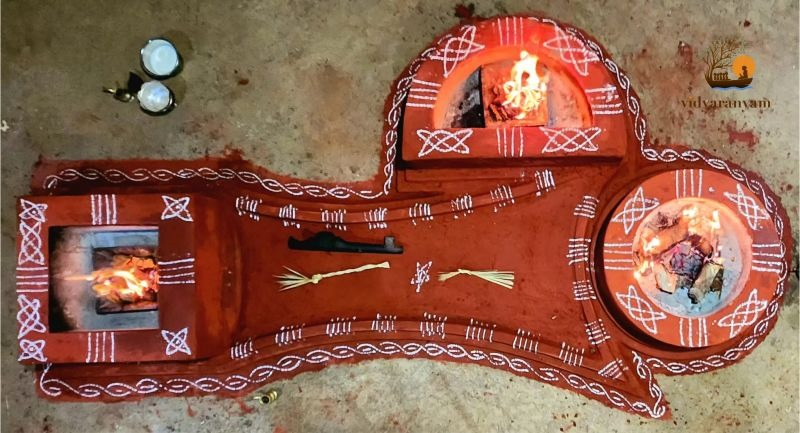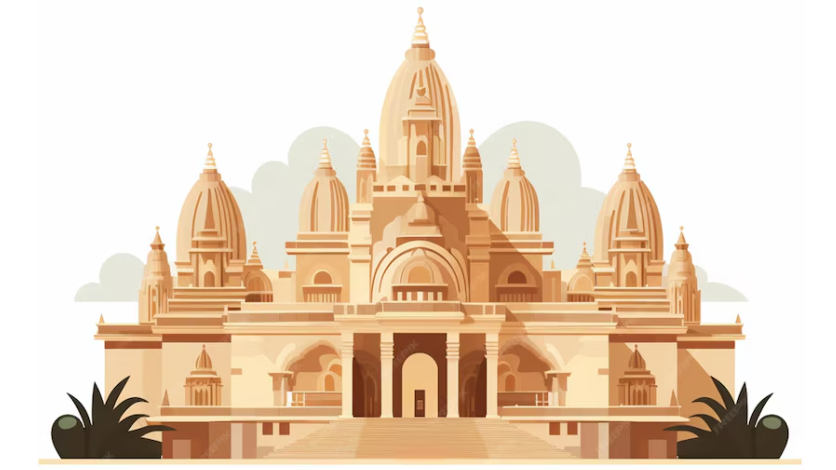Sacred Geometry In Hindu Temples Or Mandirs
The principles of sacred geometry are applied in building Hindu temples. Since temple is a generic word for place of worship, we will use the more appropriate word which is Mandir which is specific to Sanathana Hindu dharma in this article.
Various precise geometric shapes like squares and circles are seen in mandirs. This is to be expected as the Tretaagni or the three sacred fires are lit in Vedi or altars of 3 different geometric shapes — Garhapatyaagni (round), Dakshinaagni (half-circle), and Aavahaneeyaagni (square). These Vedis or altars are meticulously constructed to have the same area.

The Vedic rituals are so ancient 6,000 to 12000 years old or more as per various estimates. However, the Vedic pandits have a good command of geometry. The Vedic pandits have studied the Vedangas which are part of the Vedic education system and they have a couple of subjects related to mathematics which come under the Kalpa and Jyotishya (especially Sidhanta).
Furthermore, the muhurta and Hindu calendars require highly precise and detailed mathematical calculations for their tabulations. Therefore, it is common for temples (mandirs) to be constructed with equally precise proportions within this framework.
That perfectly aligns with a core practice of Hinduism: making a very specific offering at a very specific time from a precisely constructed Vedi or altar, as an expression of gratitude to the divine cosmic force.
- Fractal geometry is a thing that is commonly noticed in the Vedic mandirs and devalayams. This refers to the repetition of patterns in a unique way to create an impression of “infinity.”
- The core principles based on which a mandir is built are enumerated in “Vastu Shastra.” This is the age-old science of India specific to construction design and architecture.
- The sacred geometric diagrams, known as ‘Mandala Patterns,’ serve as guidelines for the layout and carry spiritual significance. These patterns are derived from the ‘Vastu Purusha Mandala,’ a square-shaped mandala that represents the universe and ensures that the mandir is attuned to the divine forces.
- Vastu Purusha Mandala is a framework for the layout of a mandir, providing guidance about many significant aspects. These aspects also include directions regarding where the idols of deities need to be placed. The exact number of mandalas that a given mandir has depends on the concerned design principles, the area, and the layout.
- Varied patterns of mandalas can be seen in different mandirs across Bharat. Both the design and the number of mandalas vary significantly from one region to another, depending on the diverse traditions and practices of each area.
- Every mandala of a mandir is an indicator of key concepts of spirituality or different planes of existence. This is a significant factor explaining why there are so many different kinds of mandalas, even one mandir is taken into consideration.
 The layout of the pillars, structural dimensions, and the design of the courtyard, among other elements, exemplify the principles of sacred geometry. In general, all these dimensions adhere to the ‘divine ratio,’ commonly known in the West as the Golden Ratio, which is linked to the Fibonacci sequence.
The layout of the pillars, structural dimensions, and the design of the courtyard, among other elements, exemplify the principles of sacred geometry. In general, all these dimensions adhere to the ‘divine ratio,’ commonly known in the West as the Golden Ratio, which is linked to the Fibonacci sequence.- The complicated components of geometry in the mandirs highlight the extraordinary knowledge and abilities of our ancestors in the areas of engineering and mathematics.
- The orientation and alignment of mandirs are usually such that they face east. This ensures that the first rays of the sun touch the mandir, and it’s an aspect that signifies enlightenment.
- In mandirs, axiality, symmetry, and proportion are treated as the most pivotal elements, because they reflect the divine order of the universe.
- In addition, a very unique place has been chosen as a mandir site. The Tirumala mandir can be taken as an example. It is located atop a range of 7 hills and the specific hill where it is constructed has a greater height than the other six hills. Further, the mandir has been built on the northeastern part of the tallest 7th hill. According to standard Vastu principles, an ideal construction site should have the southeastern portion at a higher elevation to protect against the southwest monsoon. This underscores the fact that temples are not only built to precise dimensions as outlined in sacred texts, but the site for a temple is also selected based on specific geographic locations, in accordance with the established principles of Vaastu Shastra.
Additionally, it is evident that nearly all mandirs feature one or more yantras or geometric diagrams, composed of various combinations of squares, triangles, and circles, arranged in highly specific patterns
All these facts support the main argument of this article: that there is a sacred geometry in the construction of Hindu mandirs. They are not built casually, but according to a very specific design outlined in the sacred scriptures.
